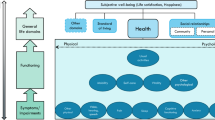Abstract
Summary
Three different approaches to measuring quality of life have been developed. Global scales (e.g. time trade-off, visual analogue), multi-attribute utility scales and multidimensional scales (which may be generic or disease-specific). Each of these approaches to measurement provides different kinds of information about quality of life and each can be used to provide information to healthcare purchasers concerning the relative value-for-money of health interventions.
The value-for-money of health interventions, in terms of quality of life, can be demonstrated in 2 ways: a formula-driven approach based on cost-utility analysis, which uses scales generating the unit of a quality-adjusted life-year (i.e. global and multi-attribute utility): and a non-formula-driven approach, which uses scales generating multidimensional profiles of quality of life (i.e. multi-attribute utility and multidimensional).
Analysis shows that no single approach is sufficient, and that healthcare purchasers should use a variety of types of information in their decision-making, including both cost-utility and informal approaches. Healthcare resource allocation is inevitably a value-dependent activity.
Similar content being viewed by others
References
Tengs TO, Adams ME, Pliskin JS, et al. Five hundred life-saving interventions and their cost-effectiveness. Risk Anal 1995; 15: 369–90
Torrance Gw. Measurement of health state utilities for economic appraisal. J Health Econ 1986; 5: 1–30
Torrance GW, Sackett DL, Thomas WH. A utility maximization model for evaluation of health care programs. Health Serv Res 1972; 7: 118–33
O’Brien B, Viramontes JL. Willingness-to-pay — a valid and reliable measure of health state preference. Med Decis Making 1994; 14: 289–97
Wagenaar WA. Paradoxes of gambling behaviour. Hillsdale: Earlbaum, 1988
Tsevat J, Goldman L, Lamas GA, et al. Functional status versus utilities in survivors of myocardial infarction. Med Care 1991; 29: 1153–9
Skavem K. Quality of life in epilepsy: comparison of four utility measures. Qual Life Res 1995; 4: 489–90
Hyland ME, Sodergren Sc. Development of a new type of global quality of life scale, and comparison of performance and preference for 12 global scales. Qual Life Res 1996; 5: 469–80
Borg G. A category scale with ratio properties for intermodal and interindividual comparisons. In: Geissler HG, Petzold P, editors. Psychological judgement and the process of perception. Berlin: VEB Deutscher Verlag der Vissenschaften. 1982: 25–34
Bergner M, Bobbit RA, Carter WB, et al. The Sickness Impact Profile: development and final revision of a health status measure. Med Care 1981; 19: 787–805
Kaplan RM, Bush JW. Health-related quality of life measurement for evaluation of research and policy analysis. Health Psychol 1982; 1: 61–80
EuroQol Group. EuroQol — a new facility for the measurement of health-related quality of life. Health Policy 1990; 16: 199–208
Ware JE, Sherbourne CD. The MOS 36-item Short-Form Health Survey (SF-36). Med Care 1992; 30: 473–83
Hyland ME. A reformulation of quality of life for medical science. Qual Life Res 1991; 1: 267–72
Hyland ME. The items in quality of life scales: how item selection creates bias and how bias can be prevented. Pharmacoeconomics 1992; 1: 1112–90
Rutten-van Molken MPMH, Custers F, Van Doorslaer EKA, et al. Comparison of performance of four instruments in evaluating the effects of salmeterol on asthma quality of life. Eur Respir J 1995; 8: 888–98
Hyland ME. Antiasthma drugs: quality of life rating scales and sensitivity to longitudinal change. Pharmacoeconomics 1994; 6: 324–9
Hyland ME, Ley A, Fisher DW, et al. Measurement of psychological distress in asthma and asthma management programs. Br J Clin Psychol 1995; 34: 601–11
O’Boyle C. Quality of life in palliative care — seeing the trees. In: Ford G, Lewin I, editors. Managing terminal illness. London: Royal College of Physicians, 1996: 37–50
Kind P. Weighting life expectancy for quality: whose values count? Qual Life Res 1995; 4: 447–8
Patrick DL, Peach H, Gregg I. Disablement and care: a comparison of patient views and general practitioner knowledge. J Royal Coil Gen Pract 1982; 32: 429–34
Hyland ME. Health and value: the values underlying health measurement and health resource allocation. Psychol Health. In press
Evans JStB. Bias in human reasoning: causes and consequences. Hillsdale: Earlbaum, 1989
Donaldson C. Formulate don’t formularise. BMJ 1994; 308: 906
Hadorn DC. Setting health care priorities in Oregon: cost effectiveness meets the rule of rescue. JAMA 1991; 256: 2218–25
Hyland ME, Crocker GR. Validation of an asthma quality of life diary in a clinical trial. Thorax 1995; 50: 724–30
Author information
Authors and Affiliations
Rights and permissions
About this article
Cite this article
Hyland, M.E. Quality-of-Life Measures as Providers of Information on Value-for-Money of Health Interventions. Pharmacoeconomics 11, 19–31 (1997). https://doi.org/10.2165/00019053-199711010-00004
Published:
Issue Date:
DOI: https://doi.org/10.2165/00019053-199711010-00004




